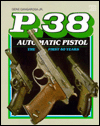| P.38
Automatic Pistol, the first 50 years
by Gene Gangarosa, Jr. Stoeger Publishing Company, 1993, softcover 272 pages ISBN 0-88317-170-8 $16.95 review by Noel Tominack
|
|
|
|
|
|
presents
Book Review,
August 2001:
| P.38
Automatic Pistol, the first 50 years
by Gene Gangarosa, Jr. Stoeger Publishing Company, 1993, softcover 272 pages ISBN 0-88317-170-8 $16.95 review by Noel Tominack
|
|
Realizing that firearms development
does not occur in a vacuum, Gangarosa takes the reader on a whirlwind tour
of history and geography that not only explains the development of the
P.38, but places it in the greater
context of world history both during
and after World War Two. Anything that has a connection to this pistol
is covered in this book. Vintage advertisements, historical photographs,
and many detailed black-and-white
photographs of the guns help illustrate
the author's narrative.
Our tour begins at the Carl Walther Waffenfabrik circa 1908 with the introduction of its first pistol, the Model 1. From there the story progresses through several other designs, with some emphasis placed on the very innovative Models PP and PPK, up to the Heeres Pistole--the prewar commercial version of the P.38.
After a chapter examining the P.38
and its function in-depth, the story continues with the first actual appearance
of a P.38 in the book at Chapter 4. Over the next four chapters Gangarosa
focuses solely on the
wartime pistols, weaving in the
events of World War Two with the stories of how other factories began to
produce P.38's. Photographs tell the tale of sacrificing the traditional
high quality fit and finish for increased
production, and each manufacturer's
slide markings are represented with line drawings.
Barely halfway through this book,
World War Two is over, but the tale of the P.38 goes on. This history
includes the continued production of "Grey Ghost" pistols manufactured
by France in the captured Mauser factory; and
captured examples being pressed
into service by nations once under Nazi occupation. Gangarosa then
goes on to discuss Walter's rejuvenated production with the help of Manurhin
in France; and the adoption of the
P.38 in the postwar German military
as the P.1. Once again, line drawings of various slides and their
markings abound. This part of the tour ends almost where it began--with
Walther offering a version of the P.38 for commercial sale.
Gangarosa then moves the emphasis to the successors to the P.38, including the P4, P5, P5C, and P38K (a short-barreled version of the venerable P.38 design). He also brings us into the modern era of "wondernine" pistols by comparing Walther pistols with those of its counterparts from other factories. Finally, the tour is completed with a brief primer on P.38 collecting and a chapter discussing how much the P.38 has influenced other later pistol designs, including the Beretta Model 92.
This book is a wonderful "entry level" book for crufflers. It presents its information in a clear and easily assimilated format, and Gangarosa includes a copious amount of photographs, drawings, and charts that effectively amplify the text. The book places great emphasis on readability, and as such it makes for wonderful recreational as well as informational reading. Indeed, part of what makes Gangarosa so successful is his writing style. Clear and lucid, he manages to avoid excessive jargon and technospeak while still conveying rather esoteric historical and technical information. An example can be found in his treatment of Manurhin produced Walthers:
In 1950, the Manufacture de Machines du Haut-Rhin (Manurhin) of Mulhouse, France, negotiated with Walther and won the exclusive European production license for PP and PPK pistols. This agreement and subsequent production benefitted Walther in at least three ways: it providedGangarosa hass written an excellent all-purpose guide to the P.38 pistol that will satisfy casual collectors, and inspire serious ones to research the fascinating history of these pistols even further.
Walther with a steady royalty income; it gave Walther's people continued experience in firearms manufacture, inspection, and quality control; and its licensed products kept the Walther name alive in the highly-competetive world of fireamrs sales.Because the Manurhin people had to start from scratch, tooling up for the Walther pistols took several years. The original machines and drawings used to manufacture PPs and PPKs had been lost to the Russians and threfore had to be recreated. Manurhin began production of the PP in 1952, followed by production of the PPK in 1953...
In 1953 the Thalson Company of San Francisco, California, began to import Manurhin-made Walther PPs and PPKs into the U.S. Maurhin marked these early pistols on the left slide surface with its own logo--a wheel with 'Manurhin' running through the center. In front of the company mark was the legend 'MANUFACTURE DE MACHINES DU HAUT-RHIN' and after it was a slide inscription that read 'LIC. EXCL WALTHER MOD. PP (or PPK)' at the bottom. The magazines were also marked with the company symbol...and the company only imported them for three years.
P.38 Automatic Pistol, the First 50 Years is available from Amazon.com. Click on the image to order:
 |